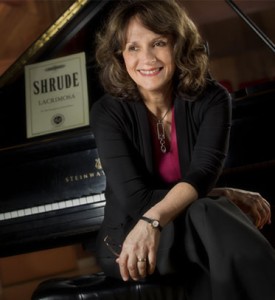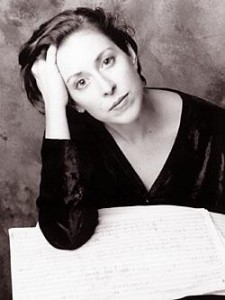
Last week the Composition Department at the University of Michigan hosted two distinguished guest composers: Susan Botti and Marilyn Shrude. Their visit was marked both by an appearance at our weekly Composition Seminar class and, most importantly, performances of their work with Marilyn Shrude leading off a recital by her husband – renowned Saxophonist John Sampen – and Susan Botti featured as a composer and vocalist in the heart of University of Michigan Symphony Band’s inaugural performance of the year.
Mr. Sampen’s recital last Thursday was one of the more unique performances I’ve attended, continuously presenting a handful of works for saxophone without any pauses thanks to pre-recorded comments from each composer played in between the pieces. Some of these were straight-up verbal program notes, while others – like Ms. Shrude’s – set a backdrop for the forthcoming music. These oral preambles were not the only special aspect of the recital’s production: each work was paired with a visual accompaniment. Supplementary images we projected on a screen in conjunction with each piece, the most compelling and significant of which was the animation paired with Ms. Shrude’s composition, Trope (2007), written for alto saxophone and a pre-recorded tape of other saxophones.
Trope’s performance – the evening’s first – was set in darkness broken only by the auditorium’s projector, which displayed the beautiful animation I just mentioned. Given the darkness and the un-processed qualities of the tape, I found myself drawn into the sound as I attempted to locate where the saxophones I heard were coming from. The music itself is very closely written – neither the live nor taped parts leave the instrument’s middle register – and serene, at times using the multiple saxophone parts to create harmonies and, at others, playing timbral tricks with the instruments’ homogenous sound. The animation reflects the musical texture, and when the saxophones are united, only one line moves across the screen, while it splits into other, fainter lines when the sonic texture becomes more variegated. I was deeply engaged with the work’s visual element and felt it perfectly complemented Ms. Shrude’s gentle and tender music.
Despite the presence of multimedia throughout the evening, technology was not a prominent a feature of every work on the program. Japanese composer Fuminori Tanada’s Mysterious Morning III (1996) and William Bolcom’s A Short Lecture on the Saxophone (1979) solely featured Mr. Sampen’s talents, while the remaining three works all paired the saxophone with electronics – both interactive and pre-recorded. I mention Mr. Sampen’s “talents” and not simply his “playing” because A Short Lecture on the Saxophone is more of a dramatic work than a musical one. Essentially, the piece calls for Mr. Sampen to (seemingly) tell the story of his life as a saxophonist, coloring the spoken text with instrumental squeaks, over-played etudes and other demonstrative musical tidbits. The piece overflows with charm and humor, which more than compensated for the general absence of much musical substance. Of course, the point of the piece (if the title doesn’t make this clear enough) isn’t purely musical, and I was happy to see Mr. Sampen delightfully put his personality on display alongside his virtuosic ability on the saxophone.
Mr. Tanada’s Mysterious Morning is strictly musical, though not conventional in any way, at least in the grand scheme of things. The work focuses on the saxophone’s multiplicity of timbres and traverses – as thoroughly as any work I’ve heard – the full range of dynamics and multiphonics the instrument is capable of producing. Structurally, the piece is straightforward and circular, with a succession of musical modules defined more by color than melodic/thematic development. Continuities arise, therefore, through relationships of timbre, a method that reaps its reward when the multiphonics that open the piece return at the work’s close. To my surprise, Toru Takemitsu’s Distance (1972) for saxophone and interactive “sho” (the sounds for which were performed by David Badagnani), similarly focuses on timbre. Extended techniques abound in the saxophone part, which is fleshed out with synthesized harmonies in the electronics part. The technical rigor of these two works seemed to be no challenge for Mr. Sampen’s ability as he drew a thread of lyricism through each work’s disparate coloristic landscape.
The final works for me to discuss – Mark Bunce’s Schrödinger’s Cat (2008) and Morton Subotnick’s In Two Worlds (1988) – shared, along with Takemistu’s Distance, a deep interaction between Mr. Sampen’s Saxphone and a free-standing, interactive electronics part. Schrödinger’s Cat is the product of Mr. Sampen’s collaborator and engineer, Mark Bunce and features the saxophone with more approachable melodies than any of the evening’s other works. Mr. Sampen flows through a synthesized landscape of extended tertian sonorities with an improvisatory air about his playing. Like Ms. Shrude’s Trope, the musical journey in Schrödinger’s Cat was elegantly complemented by its visual accompaniment, this time a simple series of still images. In Two Worlds featured the most memorable electronics part of the evening – an orchestra of cheesy synthesized sound akin to the notorious electronic orchestrations produced by Wendy Carlos in the 1960s. As wonderfully enjoyable as Mr. Sampen’s performance was, I could not look past the ‘dated’ sound world of the electronic part, which was made more obvious by Mr. Sampen’s cuing his accompaniment via foot-peddle. I recognize the innovation achieved with In Two Worlds, but I suppose my youthful ears (though I am older than this piece) are simply less sympathetic to the Mr. Subotnick’s synthesized sounds than they are to, say, Prince’s.

Susan Botti’s time in the spotlight came about 24 hours after Marilyn Shrude’s when the venerable Michael Haithcock took the stage of Hill Auditorium with the University of Michigan Symphony Band. As I mentioned in my opening, Ms. Botti was featured in the middle of evening’s program, book-ended by Percy Grainger’s Three Miniatures and an arrangement of Bach’s Passacaglia and Fugue in C Minor. I’m going skip those because Grainger and Bach are, well…dead, and I’ll mention the program’s fantastic opening work – Ron Nelson’s Epiphanies (Fanfares and Chorales) (1994) – before moving on to Ms. Botti’s compositions. Epiphanies begins with towering, dissonant sonorities that are contrasted – surprise, surprise – with more tonal, chorale-like music before going on a long, dramatic musical journey. The work’s transient yet tangible harmonies and textures grabbed me like one hopes a concert-opener will, and I couldn’t have been happier with this personal premiere.
Susan Botti’s first work on the program, Terra Cruda (2011), reclaimed the modern musical elements introduced by Epiphanies that were lost in the ponderous Bach arrangement (that just isn’t a piece I enjoy, even when it is played on organ). Ms. Botti’s harmonic sensibility doesn’t seem to be dogmatic at all, and clearly values expression above any aesthetic preferences. Most exemplary of my assertion is a moment about a quarter or third into the piece where the unstable and slippery harmonic rhythm of the opening section gives way suddenly and beautifully to a quiet and unmoving chord sustained by a single, tremolo-ing harp. Moreover, the incongruity of this moment is representative of the entire piece, which is a deliberate, “exploration,” that lacks, “the rubric of a strict formal structure,” according to the program note. My old composition/theory professor Anthony Brandt would have classified Terra Cruda as a “one-way trip”, meaning its musical destination is unrelated to the place from which it departs. There is plenty of music under the “one-way trip” umbrella I enjoy, but Terra Cruda just didn’t work for me. Appropriately, perhaps, the music’s refusal to develop itself beyond the most brief and nominal suited the title’s english translation, “raw earth”. As the piece passed convivially from one stimulating texture or moment to another, I began to wish Ms. Botti had left some of her ideas in the oven a little longer.
The second Susan Botti composition on the program, Cosmosis (2005) for soprano, small wind ensemble and women’s chorus, was uproariously entertaining and dramatic, a much more convincing product of the “theatrical influences” Ms. Botti noted in her program note for Terra Cruda. The work’s text comes from poetry by May Swenson fictionalizing an experiment performed in the SkyLab space station to determine if a spider could spin a web in zero gravity. The soprano part represents the spider, ‘Arabella’, while the chorus is used in the classical Greek style, providing commentary while at moments augmenting the soloist’s music with various vocal colorings and harmonies. Ms. Botti performed the soprano part to great success. Her talents as a vocal performer cannot be understated and, on this evening, matched Cosmosis in terms of mastery. The piece is a fantastic, simultaneously impulsive and continuous, tied together by the fascinating dialogue between Ms. Botti and the chorus. I have never heard a piece use so many different vocal sound effects (i.e. whispering, shouting, laughter, different ‘tones’ of singing, etc.) so successfully. Most amazing of these came in the work’s closing bars wherein the chorus imitated the sounds of a radio searching for a signal and then landing, seemingly randomly, on the ranting of talking heads and familiar rap and country songs. Although Cosmosis was ostensibly more materially diverse than Terra Cruda, the piece is much more clear, and – in my opinion – came off Friday night as a complete triumph for Susan Botti and the Symphony Band.
